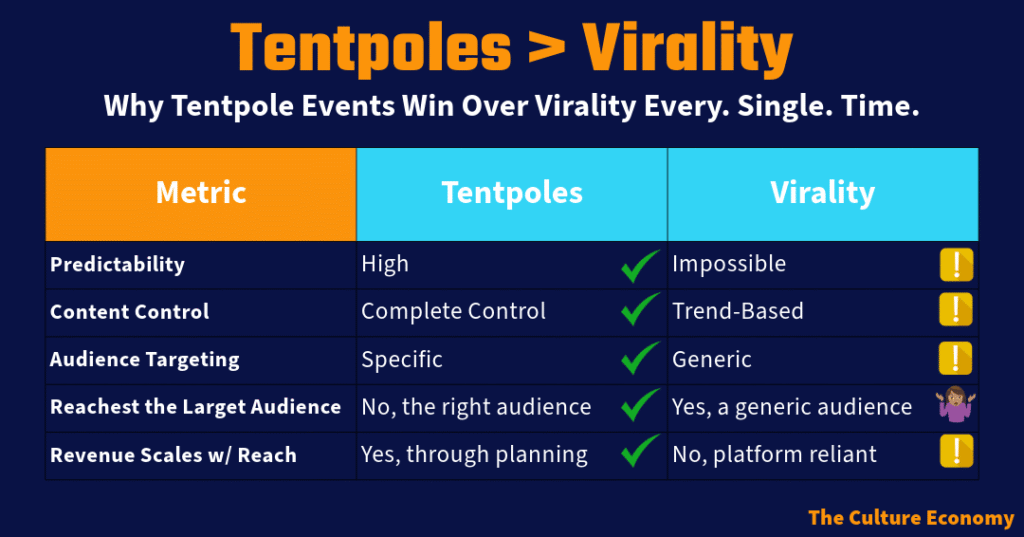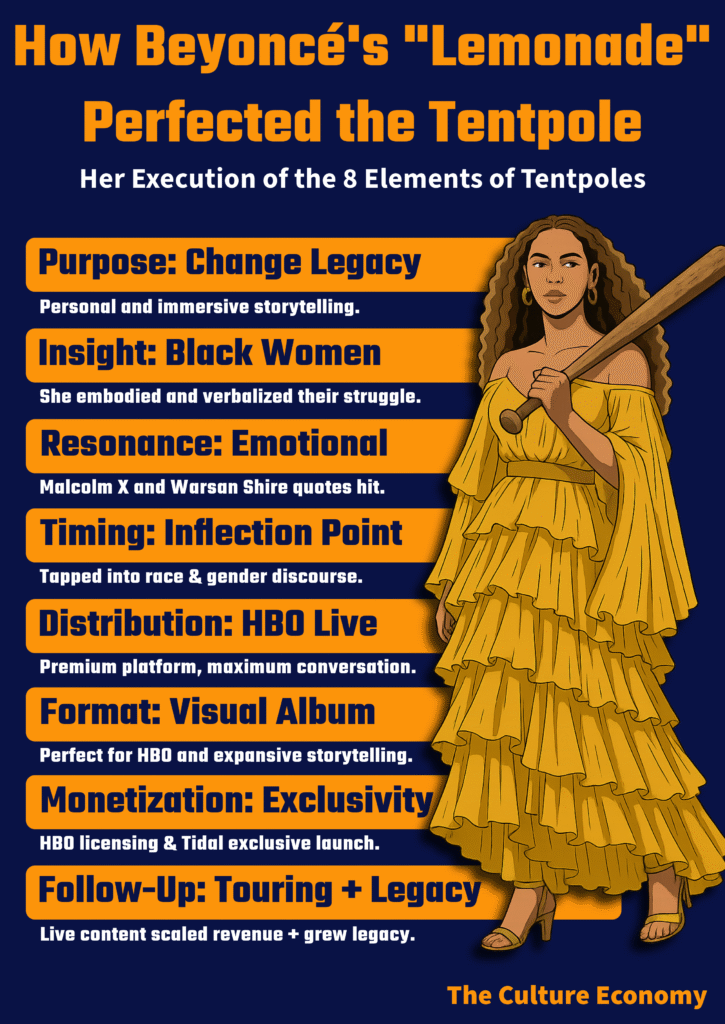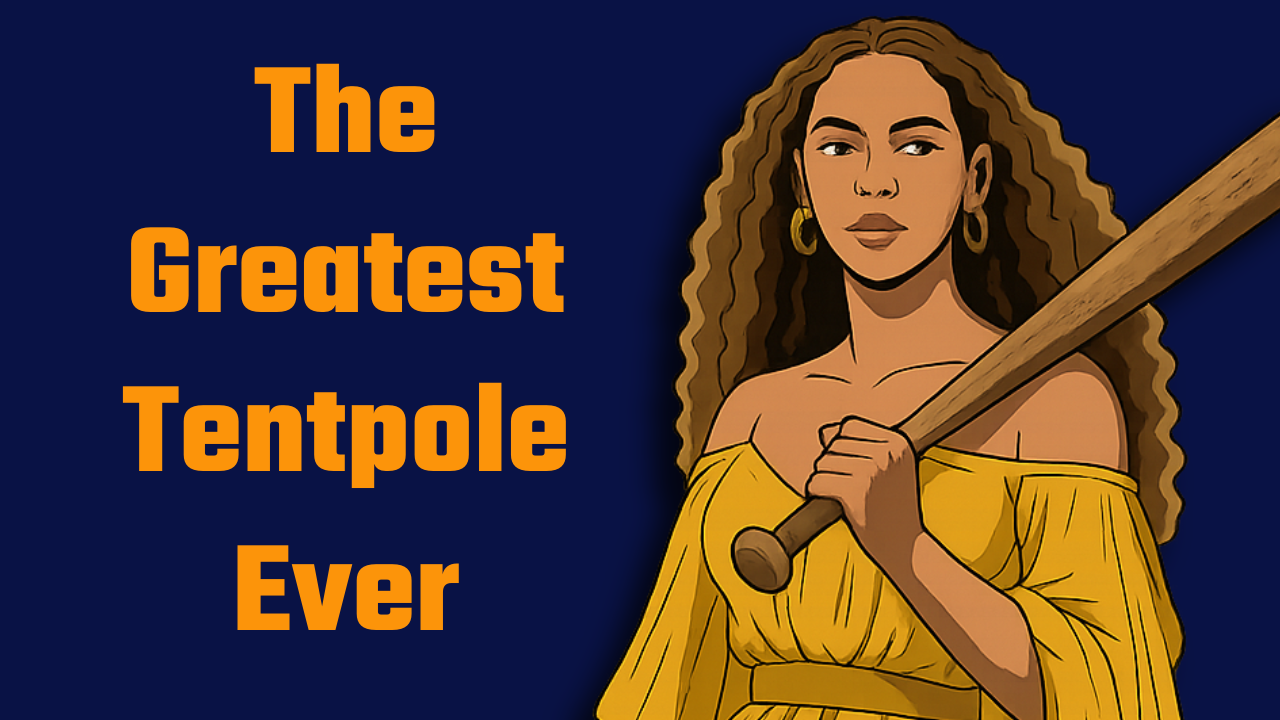Tentpole Strategy, Vol. 1
The smarter alternative to chasing virality. And how major cultural moments create lasting impact.
Welcome back, folks! We’re now on edition #4 of both The Virality Paradox series and the newsletter as a whole. We are up to 90 subscribers now, and I thank you all for taking part in this journey. Hopefully you’re getting something out of it!
I use AI as my personal editor for these newsletters. For the opener below, the robots suggested I was a little long-winded and recommended I cut down my analogy to something less verbose. But I don’t write short. I write strong. Thus, I went with my original wording. Let me know what you think!
Now, let’s get this started!
To recap this virality series thus far:
- Virality is magical but terribly unpredictable.
- Virality is fleeting, as is the chance to monetize it.
- Virality is inequitable, particularly for Black creators.
Add that all up, and to me, virality is like smoke.
It rises fast. It fills the room. It gets attention. It even causes a visceral reaction if you get consumed by it.
But it never lasts. It vanishes almost as quickly as it comes; impossible to hold, easy to chase, and useless on its own. Eventually, it seeps off into the ether.
High-impact, tentpole content, though? That’s firewood.
It does a distinct job. It’s sustainable. It can be restocked.
But you need not overdo it, because when used with intention, a small amount can fuel your fire long enough for people to gather, feel the warmth, and stay awhile.
So while smoke may catch everyone’s attention. Firewood makes sure everyone’s warm.
What is a Tentpole Event?
A tentpole event is a planned, high-impact, repeatable cultural moment that aligns with a creator’s overall narrative and monetization. It can be used to drive strategic, consistent, and growing engagement with your specific audience and beyond.
Tentpoles can range from a highly produced piece of scripted content, to an in-real-life community event—and anything in between.
A great example of a tentpole event is the Super Bowl. If you’re a fan of the NFL, you watch every week, and you probably digest entertaining or educational shoulder content about the league on at least an occasional basis. But those of you who partake in those daily and weekly activities only make up a fraction of the NFL’s audience. The NFL gets anywhere from 20 million to 35 million viewers for its weekly regular-season scheduled games.
But for the Super Bowl?
Over 127 million viewers tuned in, primarily through TV, but also in person!
So what exactly does the Super Bowl do for the NFL that its many other games don’t?
Before anything else, it gives the NFL purpose. It’s a league about winning and crowning a champion; thus, making the Super Bowl the height of the league’s season-long march.
It’s also a timely affair. People know the Super Bowl’s date months, and for the real diehards, years in advance. It’s a recurring affair that NFL fans and non-NFL fans alike often have circled on their social calendars.
Throughout the rest of mainstream media, the Oscars, BET Awards, the Grammys, “very special episodes”, political debates, and other sports championships all serve as tentpole events.
In more verticalized offerings, conferences, launches, limited series, holidays, or mega livestreams can serve as tentpole events, too.
What they all have in common is that they’re:
- Purposeful
- Timely
- Repeatable
- Built Around a Culture Moment or Audience
But why do these work? Why do suddenly 80m people who weren’t really watching the NFL throughout its regular season show up on an otherwise random Sunday in February, AND the NFL is able to extract so much value from that mega burst in viewership?
- Anticipation and Urgency: Tentpole events like the Super Bowl are designed to make you anticipatory through the preceding 18 intense weeks of regular season games, a brutal playoff tournament, a headlining musical performance, and a hundred super creative commercials. It also creates a sense of urgency—this game only happens once a year, and “everybody” is talking about it.
- Easy to Rally Around: Tentpole events just make sense. For an NFL fan and consumers of pop culture, it just makes sense to watch the league crown a champion and one of the world’s biggest musical stars perform live. Just like if you’re an iOS Developer, it just makes sense to go to Apple’s Worldwide Developer Conference—for Pete’s sake, it’s in the name.
- Signals Importance: The Super Bowl makes it clear—it’s a big deal. On top of calling itself “super”, the NFL advertises its game to (at minimum) 40 million people a week, associates itself with the biggest names in pop culture, and it makes sure to tell you how many people watch it year after year.
- Scalable Monetization: Even though the NFL bundles its Super Bowl into a broader set of media packages, believe me, the price of those packages is reflective of the NFL getting its cut of the revenue—an estimated $800m Fox sold in ad space during the 4 hours in which my Eagles beatdown the Chiefs! Like any good tentpole event, the Super Bowl has a clear monetization strategy that primarily builds on whatever is already working in the regular season. Even though the audience type and size change, its primary monetization method is scalable enough to adapt.
Tentpoles > Virality
Once a creator learns about tentpoles, I actually can’t understand why they would still get stuck on the viral train. Tentpoles are simply better than virality in almost every way. Virality’s one main advantage is that it may reach a gazillion people in 24 hours, but (a) that seldom happens, (b) it’s impossible to predict, and (c) it almost assuredly doesn’t put your content in front of the right people.
But when it comes to predictability, a tentpole is something you can plan for.
When it comes to finding the right audience, tentpoles allow you to design something for the exact audience you want.
Whereas virality is usually where the softest, fluffiest, plain-vanilla takes rise to the top, tentpoles are all about being different, standing out, and making a mountain out of the molehill you and your audience care about.
And as far as monetization goes, you’re lucky if you make a dime off the 1,000x views you got from that viral post. YouTube is the only major platform where the model somewhat scales with virality, but even then, you’re likely to see your RPMs drop when you get a sudden burst of viewership. With tentpoles, because you can plan around having a large audience, you can employ a monetization model that scales with the size of your audience.

Help Spread the Word on LinkedIn
Before the Tentpole Event
I’m sure you want an example of a successful tentpole event that isn’t the Super Bowl and comes from the creator economy. But before I do that, it’s crucial to understand that tentpole events don’t happen in a vacuum. Where a tentpole event is the firewood, the preexisting foundation of your creator business is the kindling.
So, before you can launch a tentpole, you have to have some things already established as a creator. After all, 127 million people aren’t going to show up for the championship of a brand new sports league just because they call it the “Super Ball”.
Here’s what’s needed before you can even think about kicking off a tentpole:
Clear Brand Promise: It must be clear what you are known for. Are you known for having the world’s best athletes and football action? Are you the funniest impressionist? Whatever it is, who you are and what you deliver for your audience must be clear.
Consistent Base Content: If you’re a creator, your content is effectively your brand. Thus, you need to have a consistent, brand-defining library of content that pre-Tentpole viewers know you for—and post-Tentpole viewers discover you through.
Audience Access or Ownership: While ownership of your audience is preferred, the key here is having an audience, period. You can’t promote a Tentpole event if no one is around to hear it.
Platform Momentum: You don’t have to have big numbers, but you need some traction; otherwise, how do you know if the tentpole event you’re planning is something your audience even wants?
Distribution Plan: While you should, of course, pull new marketing levers when promoting your tentpole event, you should already have a good idea about how to get your audience to act on it. Whether that’s through CTAs in your content, collaborating with other creators, or advertising your site, you should already have a good idea of how to attract users to your tentpole event, because you’ve already been doing so with your preexisting content.
The 8 Ingredients of a Successful Tentpole
Once you have the foundation for a tentpole event, you can start planning. Here are the 8 things I’ve found to be necessary for a successful tentpole launch:
- A Clear Purpose – What’s your primary goal? Reach, revenue, press, leads?
- Audience Insight – What does your audience want? What do they want from you? And where do those answers overlap? Do they want to be entertained, educated or driven to action?
- Resonance – You know what the user wants from the tentpole, but does the content you’re delivering connect with your audience in an emotional, cultural or prideful manner?
- Timing – Does the launch date take advantage of some external wave or are you carving out your own moment on the calendar?
- Distribution Strategy – On what platform will this tentpole take place? How will you market it? Have you done that before? What new tactics will you employ?
- Format Fit – Is your tentpole best suited for your primary platform or somewhere else? If the latter, how do you have to adapt?
- Monetization Plan – If revenue is a primary goal, how will you monetize a bigger-than-usual audience?
- Follow-up Strategy – You know you’re going to reach a new audience. Can you predict who those people will be? And how will you retain them?
Bonus: I really recommend using your tentpole event to make more of your audience “owned” vs. “rented”. That means having a clear way to get folks to give you their email address, visit your website, or download your app. It’s not a must for your tentpole to succeed, but I don’t see any reason you wouldn’t do this if it’s possible.
That’s a lot of ingredients—likely a big step up from the content you produce on a regular basis. But nobody said tentpole events were easy.
Case Study: Beyoncé’s Ultimate Tentpole: Lemonade
I swear we’ll get to a more social media endemic creator example, but I think it would be foolish to ignore what I consider to be an OG creator, who has leveraged social, traditional, and digital media into becoming the most celebrated creator and artist on the globe.
For those who don’t remember, in 2016, Beyoncé’s Lemonade was possibly Queen B’s magnum opus. It was an HBO-released visual album where she finally got vulnerable, personal, and reshaped her image entirely. She also changed the industry in the process. Let’s break it down based on the 8 ingredients for a successful tentpole.
Purpose: Obviously, Beyoncé is known for monetizing and getting earned media attention, so that’s already baked into a project coming from her. But this album was mainly about telling a deeply personal story about betrayal, healing, and being a Black woman. She could’ve easily done something widely appealing, on brand, or collaborated with others. Instead, she told the story that very few women of her ilk dare to tell, video-first, taking on all the narratives about her and her relationship head-on. The purpose wasn’t just music—it was to change her legacy. It’s no coincidence that in an interview with Elle, just weeks before its release, Beyonce said, “I hope I can create art that helps people heal! Art that makes people feel proud of their struggle. Everyone experiences pain, but sometimes you need to be uncomfortable to transform.“
Audience Insight: Beyoncé knew that humanizing herself and her relationship would tap into the cultural core of Black women, who have constantly been undercelebrated and misunderstood in our culture.
Resonance: She made the album both specific and cinematic, which allowed the album to reach new emotional depths with her core audience while earning the admiration of all onlookers with a “music video” that entailed the production quality of an HBO series. Plus, the play on her full emotional arc, Malcolm X quotes, famous black women cameos, and legendary poet Warsan Shire, all allowed it to speak directly to Black women, Black culture, and the culture at large.
Timing: Beyoncé doesn’t need to jump on any wave—she creates her own, and she was no stranger to the surprise album drop given the 2013 sudden drop of her eponymous album. Thus, her surprise dropping of Lemonade wasn’t new. Still, the timing of her release came at a moment when the nation was dealing with issues of race, police brutality, and a very genderized Presidential election.
Distribution Strategy: Premiering on HBO was amazing. Telling nobody what they were about to watch: brilliant. But she still managed to build anticipation. She foreshadowed it at her guest Super Bowl performance. She teased it with the announcement of her tour. She teased it with what she told the media. And with all that, came plenty of earned media and social chatter. Plus, by putting it on HBO, Beyoncé associated her release with “premium content”, which helped draw in audiences that don’t normally listen to her music.
Format Fit: Given it was a complete visual album, her previously executed iTunes drop wouldn’t have worked as well, and dropping it on YouTube as a 65-minute video didn’t really make sense at the time. Going with HBO was a novel and genius move into platform-first storytelling, as the visual album was perfectly tailored for premium TV, which could then be cut up and distributed to other places in more befitting formats of time (as clips on YouTube, as songs on Tidal).
Monetization Plan: We don’t know for sure, but it’s likely HBO paid for the exclusive rights to first air Lemonade. On top of that, she made the visual album exclusive to Tidal (her husband’s streaming service) for a period of time, which saw sign-ups and the value of Tidal soar. And, of course, she capitalized on your typical music monetization tactics: digital and physical album sales, merchandise, and publishing revenue. All of these scaled with the moment.
Follow-up Strategy: I left one piece out of the monetization part, as it was a genius part of the follow-up strategy, too. Specifically, Beyoncé immediately went on her Formation World Tour, which helped maximize the sales of any remaining tickets, increase merchandise revenue, and deepen the cultural relevance of attending her tour. And again, because the point of Lemonade was changing her legacy, the real follow-up was how the visual album would go on to live on HBO, surge on YouTube, get nominated for 4 Emmy Awards, dominate the Grammys, win a Peabody, and insert itself into countless think pieces, memes, and scholarly dissertations for years to come.

The Takeaway: Even though Beyoncé’s not a traditional creator, what she did is the manual for how to think about Tentpole events. Hopefully, her example rids you of the “going viral” mentality. Because:
- Virality is hope. Tentpoles are strategy.
- Virality goes wide. Tentpoles go deep.
- Virality fades. Tentpoles compound.
So if you’re serious about the creator business, it’s time to start thinking like Beyoncé, and not like someone trying to get on America’s Funniest Home Videos. Build your tentpole strategy today!
Wrapping Up
That does it for the first volume on Tentpole strategy. Stay tuned for the second edition next week, when we’ll dive into an endemic creator’s tentpole strategy and go over exactly how you can design your next tentpole.
Want the second volume early? Like and comment on my LinkedIn post, and I’ll DM you the early draft!
